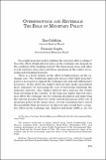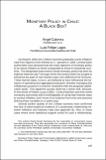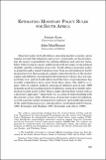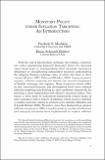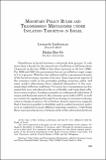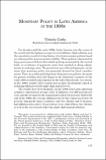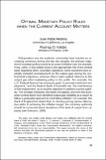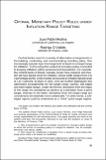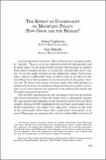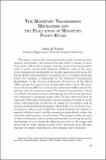Search
Now showing items 91-100 of 102
Overshootings and reversals: the role of monetary policy
Does tight monetary policy stabilize the currency after a collapse?. Does the effect of high interest rates on the exchange rate depend on the condition of the banking system? The East Asian crises and other recent currency crises have put these questions at the center of economic policymaking decisions.
Monetary policy in Chile: a black box?
During the 1990s the Chilean economy gradually cut its inflation rate from figures in the thirties to 4.7 percent in 1998. Central bank authorities have declared that the main objective of monetary policy is to reduce inflation to levels comparableto those in industrial countries. The desgnated ...
Estimating monetary policy rules for South Africa
Monetary policy in South Africa's emerging market economy, given capital account liberalization and severe constraints on fiscal policy, has the major responsability for curbing inflation and currency instability while trying to ensure sufficient growth for longer-term political stability and the ...
Monetary policy under inflation targeting: an introduction
With the end of intermediate exchange rate regimes, countries are either abandoning domestic monetary policy (by choosing super-hard pegs or relinquishing their national currencies altogether) or strengthening independent monetary policymaking (by adopting floating exchange rates, of either the clean ...
Monetary policy rules and transmission mechanisms under inflation targeting in Israel
Disinflation in Israel has been a relatively slow process. It took more than a decade for the annual rate of inflation to fall from about 18 percent in the late 1980s to less than 4 percent in the late 1990s. For 2000 and 2001 the government has set an inflation target range of 3 to percent. Whether ...
Monetary policy in Latin America in the 1990s
For decades until the early 1990s, Latin America was the region of the world with the highest average level of inflation. High inflation was the cumulative result of a long history of activist economic policies based on a disregard for macroeconomic stability. These policies culminated in large ...
Optimal monetary policy rules when the current account matters
Policymarkers and the academic community have reached an increasing consensus during the last two decades: the primary objective of monetary policy should be to control inflation (see, for example, King, 1999). A less settled issue is the appropriate role of the central bank regarding other, secondary ...
Optimal monetary policy rules under inflation range targeting
Central banks resort to a variety of alternative arrangements in formulating, conducting, and communicating monetary policy. One increasingly popular type of arrangement is based on a target range for inflation. In this setup the conduct of monetary policy is oriented to keeping inflation withing ...
The effect of uncertainty on monetary policy: how good are the brakes?
In most industrial countries, official interest rate changes tend to be 'smooth'. That is, rates are adjusted relatively infrequently and is small steps. Yet the path of interest rates that emerges as optimal from macroeconomic models is, in general, considerably more volatile. So are the paths of ...
The monetary transmission mechanism and the evaluation of monetary policy rules
This paper explores the connection between the monetary transmission mechanism -the channel through which a change in monetary policy affects the economy- and the choice of monetary policy rules to guide central bank decisions. Differente views of the monetary transmission mechanism are readily apparent ...

